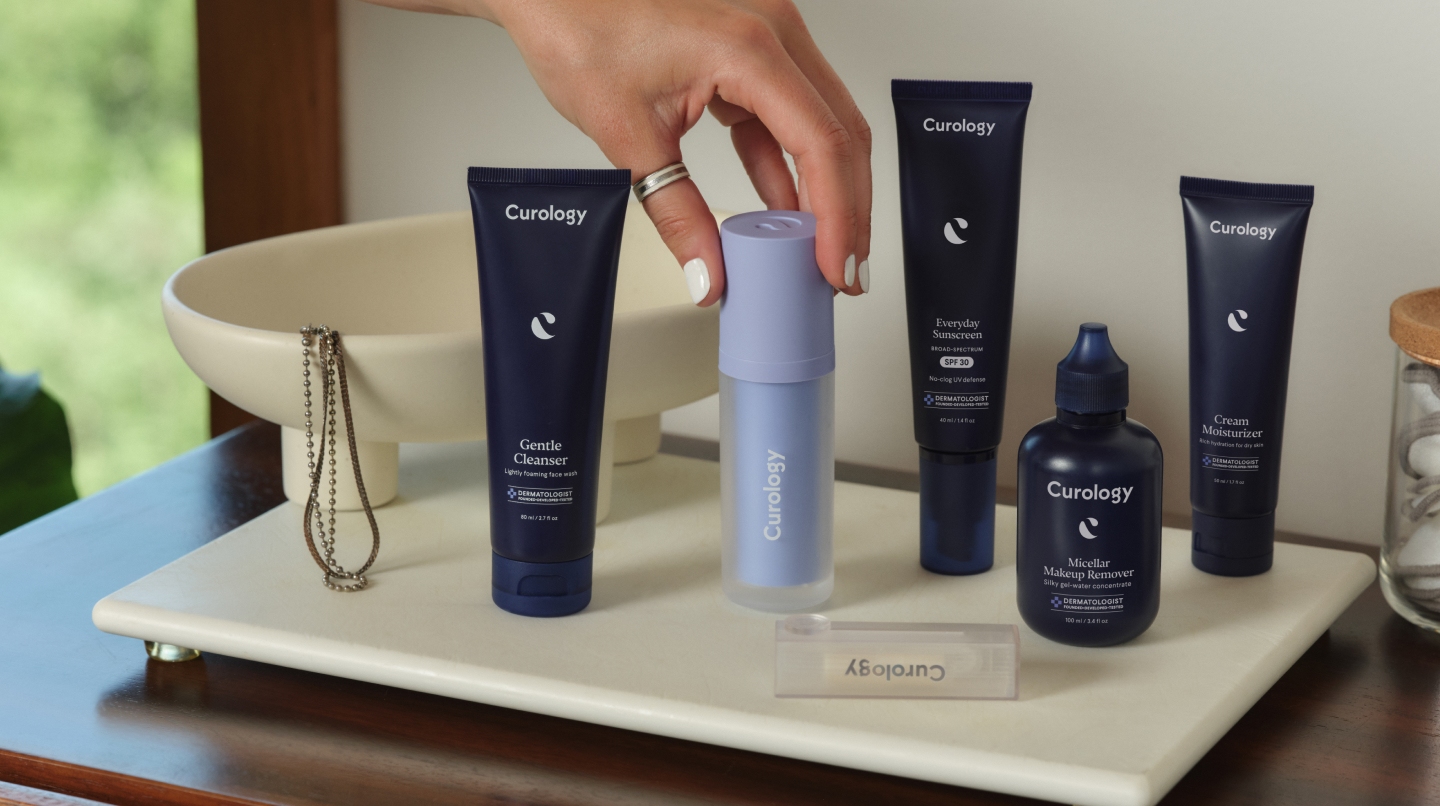How it works:
Share your skin goals and snap selfies
Your dermatology provider prescribes your formula
Apply nightly for happy, healthy skin
How it works:
How it works:
Share your skin goals and snap selfies
Your dermatology provider prescribes your formula
Apply nightly for happy, healthy skin
How it works:
Skincare trends of the past: toxic and sometimes fatal
Deadly skincare trends (eating arsenic, anyone?) from days past that are definitely not dermatologist-approved.



Beauty treatments—from hair care to skincare and makeup—haven’t always been what you’d call healthy. After all, “beauty is to die for,” or so the saying went.
And the truth is, all it takes is taking a peek into history to uncover some beauty trends that would do more than raise a brow by today’s standards.
Take the beauty norms of Victorian England, for example, when ratsbane—the white-powder form of arsenic—was a popular makeup ingredient, despite being an extremely toxic poison.¹
At the root of the English fad was the popular exoticism of Styria, a state in Austria where the practice of eating arsenic began.² Arsenic eaters aimed to exemplify the beauty standards of the times, consuming the element with the hopes of achieving smooth, creamy complexions, free of blemishes. And so began 19th century Europe’s obsession with arsenic as a beauty product that, although lethal and capable of causing great harm to one’s health, was still used by some to achieve the beauty standards of the times. Let’s flip through the history book and learn more about some of the most notoriously toxic beauty fads of the past, from arsenic to X-rays.
Arsenic complexion wafers
Arsenic is a natural element found in the earth’s crust, but in its inorganic form, it can be very dangerous when consumed. Arsenic poisoning can result in cancer, cardiovascular disease, and poor cognitive developments.³ Nevertheless, in 1890, Dr. James P. Campbell began selling arsenic “complexion wafers” that he guaranteed were “absolutely safe and harmless to anybody.⁴”
Women would nibble at the wafers or even wash with the poison, hoping to achieve an ideal complexion that was free of “freckles, black-heads, pimples, vulgar [sic] redness, yellow or ‘muddy’ skins and other facial disfigurements.” Little did they know, the arsenic was slowly killing them. Ironically, being exposed to arsenic would not only cause hyperpigmentation to worsen over time, but it could also cause the skin to break out in dark spots on the hands and feet.⁵

Photograph via the Smithsonian Institute
Arsenic in makeup isn’t the only toxic beauty trend that’s repeatedly resurged in the history of cosmetics. Lead has also been used in cosmetics since ancient times. Ancient Egyptians were one of the earliest proponents of lead-based makeup, using it as a pigment in their eyeliner.⁶
The death mask of Queen Elizabeth I
Whether they know her by name or not, these days most everyone has seen an image of England’s Queen Elizabeth, who was arguably best known for her stark, almost otherworldly pale skin. When she assumed the throne in 1558, it was a period of intense tumult for England and Ireland. After the execution of her mother, Anne Boleyn, Elizabeth was declared illegitimate and became queen only after the untimely deaths of her half-siblings who preceded her, leaving the monarchy in disarray. And so, it was all the more crucial for Elizabeth to uphold a perfect image that exuded authority, reinforced by her otherworldly chaste appearance.

Painting via Wikimedia Commons
Her ghostly complexion was the result of a foundation sometimes called spirits of Saturn or Venetian ceruse, made of white lead and vinegar.⁷ She wore it to achieve the pale skin associated with nobility at the time and also to conceal scars left from smallpox. Elizabeth took to the white lead makeup shortly after she assumed the throne and continued to wear it every day until her death 45 years later.
Over time, her pale skin began to resemble that of a corpse, and a dark blue line around her gums could be seen any time the queen flashed her teeth for a smile. Severe skin discoloration would have made her expression look smeared as if her face was slowly melting. And all the while, the lead absorbed through the skin on her face was gradually killing almost every organ in her body,⁸ including her entire nervous system, which would have given way to strange behavior.
Some believe this is why Elizabeth was known to have a short temper that worsened toward the end of her reign. In the months before her death, Queen Elizabeth refused food or drink,⁹ which may have contributed to her demise as well. She ultimately withered away, and while the official cause of death remains unknown, many believe she eventually succumbed to lead poisoning.
Mercury poisoning and skin lightening
Unfortunately, dangerous skin-lightening techniques are not unique to the days of yore. Today, skin bleaching persists as a dangerous beauty trend, despite its often lethal cost. Instead of arsenic or lead, these days, it’s mercury that’s often found in skin-lightening creams and soaps. Also known as “quicksilver” because of its metallic color and low melting point,¹⁰ mercury is extremely poisonous to humans. Although the FDA prohibits its use (except, in rare cases, as a preservative¹¹), mercury-based skin-lightening creams are still sold illegally in the United States.
Nevertheless, in 2010, a 28-year-old woman was admitted to a hospital after receiving mercury-based skin-bleaching treatments¹² at a beauty salon for 11 months. Her complaints included pain in her joints and extreme swelling in the face. Doctors soon discovered she had the nephrotic syndrome, caused by her kidneys not working properly.
In another case, a 54-year-old woman’s onset of dementia and epilepsy was linked to a skin-lightening cream with high levels of mercury, which she used daily for six years.¹³ An MRI scan revealed that her brain was covered in lesions. Both women ceased using the cosmetics in order to receive critical treatment that saved their lives.
Radium beauty products
The element radium is particularly dangerous because it’s highly radioactive.¹⁴ Exposing yourself to its radiation can damage the DNA in your cells and, in many cases (as we now know), lead to cancer. Nevertheless, once upon a time, in the early 1900s, before this was common knowledge, radium was also used in women’s beauty products. When it was discovered in the late 19th century, very little was known about its grave dangers. Radium was used in various cosmetics, notably face creams, and was touted to increase one’s—you guessed it—radiance.¹⁵
X-ray hair removal
In the 1920s, hair removal went to new extremes after Austrian physician Leopold Freund and his team noticed that X-rays—first discovered by German physicist Wilhelm Roentgen in 1895—caused hair loss.¹⁶ X-rays soon became marketed as the newest beauty trend to remove unwanted body hair. While they certainly didn’t know the dangerous side effects they could experience later in life due to this treatment, many women were burned from the treatment, often due to the technicians having very little training and experience. Excessive X-ray exposure can lead to cancer, and using it as a hair removal method is an unnecessary amount of exposure that at a minimum can result in skin damage, and at worst result in cancer.¹⁷ Waxing may sometimes feel a bit painful, but at least it's not lethal.
A cautionary tale
Throughout the history of skincare, beauty seekers have all-too-often reached for toxic skin products. The greatest irony is that, although they hoped to improve their complexions, the topical application of what we now know to be poisonous elements worsened the appearance of their skin over time. Some might even have little regard for the deadly effects of these products on the body, feeling more than willing to pay the high costs of obtaining the sometimes impossible beauty standards. The result is that some, like Queen Elizabeth, tend to rely more and more heavily on these products to improve their appearance, even as the harmful ingredients slowly kill them.
That was then, this is now
Skincare over the ages can be pretty scary, cosmetic treatments were often full of toxic chemicals and there was an abundance of unknown side effects. While beauty products like foundations and concealers are regulated now, they can still contain clogging and irritating ingredients.
Fortunately, finding radium and arsenic in your face lotion and shampoo isn’t something you have to worry about today, but if you are unsure about what may actually help your skin, and be safe, you can always see a dermatologist for in-depth advice.
If you want skincare that is custom to your unique skin, and can take all the guesswork out of it, Curology is for you. When you sign up for Curology, you’re paired with your own licensed dermatology provider to bring the expertise straight to you.
Get your personalized skincare routine with Curology
Get your personalized skincare routine with Curology


If Curology is right for you, we’ll send you a 30-day supply of your Custom Formula with a mix of active ingredients chosen for your unique skin concerns, plus any of our recommended products, for free—just pay $4.95 (plus tax) to cover shipping and handling.
P.S. We did the research so you don’t have to:
Matthew Kuivenhoven; Kelly Mason, Arsenic Toxicity. StatPearls. (2021 July 20).
Scientific American. The Arsenic Eaters of Styria.( 1869, October 2).
World Health Organization. Arsenic.(2018, February 15).
National Museum of American History.Dr. James P. Campbell's Safe Arsenic Complexion Wafers.(n.d.).
Ranjit N Ratnaike. Acute and chronic arsenic toxicity. Post Medical Journal. (2003 March 31).
BECKY LITTLE. Arsenic Pills and Lead Foundation: The History of Toxic Makeup. National Geographic. (2016, September 22).
BECKY LITTLE. Arsenic Pills and Lead Foundation: The History of Toxic Makeup. National Geographic. Ibid.
Wani, Ab Latif et al. Lead toxicity: a review. Interdisciplinary toxicology. (June 2008).
Claire Ridgway. The death of Elizabeth I and possible causes of death by Alexander Taylor. The Tudor Society.( 2016, n.d.)
United States Environmental Protection Agency. Mercury. (n.d.).
Food and Drug Administration. Mercury Poisoning Linked to Skin Products. (n.d.).
Zhang, Lin et al. Nephrotic syndrome of minimal change disease following exposure to mercury-containing skin-lightening cream. Annals of Saudi medicine. (May-June 2014).
Zellner, Tobias et al. Dementia, epilepsy and polyneuropathy in a mercury-exposed patient: investigation, identification of an obscure source and treatment. BMJ case reports.( 2016, October 28).
Centers For Disease Control and Prevention. Health Effects of Radiation. (August 6 2021).
R.M. Díaz. Radioactive cosmetics and Radiant Beauty. History and Humanities in Dermatology. (2020, September 14).
Joe Schwarcz.X-Rays and Hair Removal. McGill. (2017, March 20).
Joe Schwarcz. X-Rays and Hair Removal. McGill. Ibid.
This article was originally published on October 31, 2019, and updated on May 05, 2022.
We’re here to tell you what we know. That’s why our information is evidence-based and fact-checked by medical experts. Still, everyone’s skin is unique—the best way to get advice is to talk to your healthcare provider.
* Subject to consultation. Subscription is required. Results may vary.

Stephanie Papanikolas

Donna McIntyre, NP-BC
Related Articles
Sunscreen for eyes: How to protect your delicate skin from UV raysFoundation makeup for aging skinYour first weeks on CurologyWrinkles and other signs you’re doing it rightWhy Curology is cruelty-free and vegan-friendlyPopular Articles
Ask Curology: Is my cold breaking me out?Slugging: The dermatologist-approved skincare hack going viral on TikTokTretinoin vs retinol: What’s the difference?How to create a self-care routine that actually sticksYour 2023 skincare horoscopeTry prescription skincare
Get routine essentials

Good skin days ahead
- Breakouts
- Redness
- Fine lines
- Dark spots
- Hair thinning